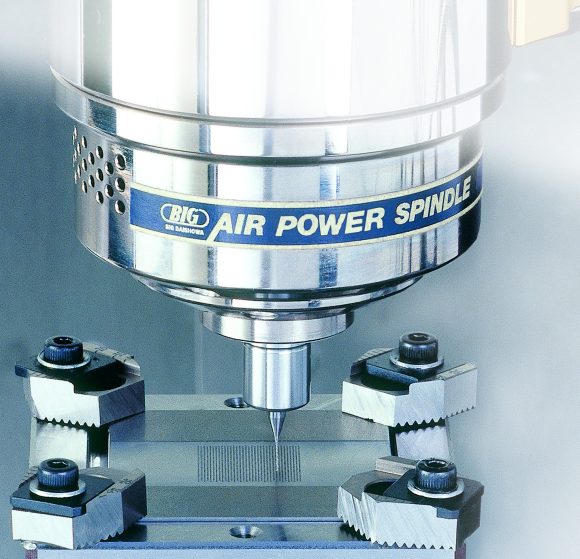Like most modern technologies, high-speed machining has come a long way since its initial rise in popularity. First enabled by new carbide tooling, faster spindles and more sophisticated coolant systems, shops in the ‘90s were amazed when spindle speeds reached 20,000 RPM. Today, it’s not unusual to see speeds 6x that—up to 120,000 rpm and higher.
High-speed machining—then and now—aims to enable faster production of large, complex parts and better results with hard-to-machine materials. But the approach isn’t foolproof; high-speed machining without a smart tooling strategy can be disastrous. In fact, using less-than-premium tooling during high-speed machining applications can erase the productivity gains and cost-savings shops hoped to achieve in the first place.
On the other hand, the right precision tooling can amplify the benefits of high-speed machining.
Considering the demands, weighing the risks
The higher the spindle speed, the higher the stakes. The risks extend to the tooling, the workpiece, the machine and even the operator. Those with any experience in high-speed machining know the common issues well:
- Heat generation and thermal damage. Higher speeds generate more friction and, therefore, more heat, which can result in deformation or premature wear to tooling, or issues with the quality of the finished workpiece.
- Excessive tool wear and breakage. When done incorrectly or with lower quality tools, consumables costs can skyrocket due to premature wear or breakage.
- Vibration. Chatter is the enemy of precision machining, and it’s a serious risk in high-speed machining applications.
Beyond the risks (and subsequent costs), high-speed machining requires a higher upfront investment in the machine itself. Spindle speed specifications are one thing, but you’ll also want to make sure your machine tool brand of choice has a reputation for quality and durability. Look for machines that feature direct-drive motors, air-driven spindle systems and magnetic bearings—all of which improve the stability, speed and response times needed in high-speed machining.
Don’t neglect tool holder quality
With the latest and greatest machine tool model, shop owners may think they’ve already won the high-speed machining battle. But skimping on costs while tooling up is like putting discount tires on a Porsche; your spindle may be ready for speeds in excess of 100,000 RPM, but if your tool holder can only handle 15,000 RPM, performance will suffer.
Tool holders built for the job of high-speed machining have two things in common: stability and balance (possible through uncompromising manufacturing and quality control). Well-balanced tooling reduces runout, which, in turn, reduces the risk of vibration. A highly stable tooling setup minimizes vibration, which protects the machine, tooling and workpiece.
The effects of runout and vibration are well known: decreased part quality, premature tool wear and even machine and spindle damage. But how can shops assess and choose tooling to avoid it? Consider the following:
-
- Find the right type of tool holder for the job. Typically, a shrink-fit holder or collet chuck is best for high-speed machining—both are naturally balanced for the job and have relatively high gripping strength. Collet chucks have an edge when it comes to vibration damping and pullout security.
- Pay attention to the AT tolerance of the tool holder. Machine manufacturers typically grind spindles to an AT1 tolerance, but that doesn’t necessarily mean the tool holder should match that. Instead, look for a tool holder ground to an AT2 tolerance—which will ensure ample, rigid surface contact and better run-out reliability.
- All balance standards are NOT created equal. You’ll notice that many tool holders adhere to ISO 1940-1 standards, which is excessive and not always feasible—particularly for smaller, lighter tools. A more recently developed standard, ISO 16084, was specifically created with rotating tool systems in mind. This standard is not expressed in quality grades (G-values) but rather in maximum rotational speeds. This makes it easier to align desired spindle speeds with tool holder choice. With this standard, operators can feel confident their tool holder is up snuff.
- Quality manufacturing matters. Great tool holders start with premium materials (H13 premium tool steel, for example) and superior production and quality control processes (grinding to mirror-like finishes, hand measuring and inspection, full in-house manufacturing). This level of quality should extend from the taper itself to the collets, nuts and retention knobs. Run your fingers along the taper, slots of the collet and threads of the nuts; are they smooth and completely free of burrs or unnecessary texture? That’s a good start.
Product spotlight: MEGA NEW BABY CHUCK
As mentioned, collet chucks are a go-to choice for high-speed machining applications—and the MEGA NEW BABY CHUCK is a winning option.
Precision ground and perfectly balanced, every component—from the body to the clamping wrench—was designed for high speeds. Shops will enjoy excellent runout in a wide range of operations, including drilling, reaming, tapping and end milling. It’s thanks, in part, to the NEW BABY collets—the world’s first AA grade collets. Plus, every NEW BABY COLLET is inspected twice to exacting standards: .00004″ at the collet nose and .00012″ at 4xD.
This guaranteed accuracy has real, positive implications. Consider this example:
- Application: a .118” carbide drill—cutting .472” deep into ANSI 1055 steel
- Test: compare two drills: one with .00008” runout and one with .0006” runout
- Methodology: for the sake of analysis, we considered a tool spent when the wear width of the relief angle reached .008”
- Results:
- The .0006” runout tool drilled 800 holes
- The .00008” runout tool drilled a whopping 2,300 holes—2.9 times more thanks to better runout accuracy
Based on those results, even if the more accurate drill is twice the price, its return on investment is still significantly greater! It’s a valuable lesson for shops looking to increase the cost-efficiency of their high-speed machining operations.
Getting things right in high-speed machining applications starts with the right machine and spindle. But all too often, shops overlook the power of a smart tooling strategy. Even if the finished parts are up to spec, hidden tool costs could be negatively impacting the bottom line. Premium tooling—the kind specifically designed for high-speed machining—is an investment in high-speed machining success.
To learn more about high-speed machining solutions from BIG DAISHOWA, visit www.bigdaishowa.com.

